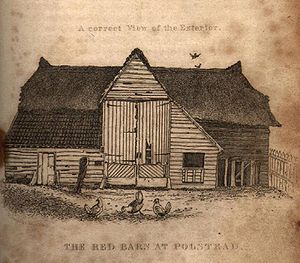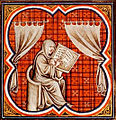Portal:Biography
The Biography Portal
A biography, or simply bio, is a detailed description of a person's life. It involves more than just basic facts like education, work, relationships, and death; it portrays a person's experience of these life events. Unlike a profile or curriculum vitae (résumé), a biography presents a subject's life story, highlighting various aspects of their life, including intimate details of experience, and may include an analysis of the subject's personality.
Biographical works are usually non-fiction, but fiction can also be used to portray a person's life. One in-depth form of biographical coverage is called legacy writing. Works in diverse media, from literature to film, form the genre known as biography.
An authorized biography is written with the permission, cooperation, and at times, participation of a subject or a subject's heirs. An autobiography is written by the person themselves, sometimes with the assistance of a collaborator or ghostwriter. (Full article...)
Featured biographies –
Susianna Levonovna Kentikian (Armenian: Սյուզի Կենտիկյան; born Syuzanna Kentikyan on 11 September 1987) is an Armenian-German former professional boxer who competed from 2005 to 2016. She was born in Yerevan, Armenian SSR, but left the country with her family at the age of five because of the First Nagorno-Karabakh War. Kentikian has lived in Hamburg since 1996 and began boxing at the age of twelve.
Kentikian is a two-time flyweight world champion, having held the unified World Boxing Association (WBA) and World Boxing Organization (WBO) female titles between 2007 and 2012, and the WBA female title again from 2013 to 2017. Additionally, she held the Women's International Boxing Federation (WIBF) title twice between 2007 and 2017. During the 2009 WBA convention in Colombia she was named the first ever female Super champion. It was announced that this belt would be called "Susi Kentikian belt" for all other future Super champions. (Full article...)
Air Vice-Marshal William Hopton Anderson, CBE, DFC (30 December 1891 – 30 December 1975) was a senior commander in the Royal Australian Air Force (RAAF). He flew with the Australian Flying Corps in World War I, earning the Distinguished Flying Cross and the Belgian Croix de guerre for his combat service with No. 3 Squadron on the Western Front in 1917. The following year he took command of No. 7 (Training) Squadron and, later, No. 3 Squadron. Anderson led the Australian Air Corps during its brief existence in 1920–21, before joining the fledgling RAAF. The service's third most-senior officer, he primarily held posts on the Australian Air Board in the inter-war years. He was appointed a Commander of the Order of the British Empire in 1934, and promoted to air commodore in 1938.
At the outbreak of World War II, Anderson was Air Member for Supply. In 1940 he acted as Chief of the Air Staff between the resignation of Air Vice-Marshal Stanley Goble in January and the arrival of Air Chief Marshal Sir Charles Burnett, RAF, the next month. He led the newly formed Central and Eastern Area Commands between December 1940 and July 1943, returning to the Air Board as Air Member for Organisation and Equipment from September 1941 to May 1942. Anderson was founding commandant of the RAAF Staff School from July to November 1943, after which he was appointed Air Member for Personnel. He again served as Staff School commandant from October 1944 until his retirement in April 1946. Known to his colleagues as "Andy" or "Mucker", Anderson died on his birthday in 1975. (Full article...)
Kealoha enlisted in the 41st United States Colored Infantry, a United States Colored Troops regiment formed in Pennsylvania. Participating in the siege of Petersburg, he and another Hawaiian soldier met the Hawaiʻi-born Colonel Samuel Chapman Armstrong, who recorded their encounter in a letter home. With the 41st USCT, Kealoha was present at the surrender of Confederate General Robert E. Lee and the Army of Northern Virginia at Appomattox Court House on April 9, 1865. After the war, Kealoha returned to Hawaiʻi. He died on March 5, 1877, and was buried in an unmarked grave in Honolulu's Oʻahu Cemetery. (Full article...)
In 1938, he moved to the United States as the recipient of a two-year Rockefeller fellowship and conducted research at Harvard University before joining the academic staff of Stanford University. During World War II, Tomasevich worked for the Board of Economic Warfare and the United Nations Relief and Rehabilitation Administration, and post-war he joined the Federal Reserve Bank in San Francisco. In 1948, he joined the staff at San Francisco State College (later San Francisco State University). He combined research and teaching there for twenty-five years until his retirement in 1973, which was broken by a year of teaching at Columbia University in 1954. Between 1943 and 1955, Tomasevich published two positively reviewed books on economic matters; one focused on marine resources and the other on the peasant economy of Yugoslavia. (Full article...)
Leonhard Euler (/ˈɔɪlər/ OY-lər; German: [ˈleːɔnhaʁt ˈʔɔʏlɐ] , Swiss Standard German: [ˈleːɔnhart ˈɔʏlər]; 15 April 1707 – 18 September 1783) was a Swiss mathematician, physicist, astronomer, geographer, logician, and engineer who founded the studies of graph theory and topology and made pioneering and influential discoveries in many other branches of mathematics such as analytic number theory, complex analysis, and infinitesimal calculus. He introduced much of modern mathematical terminology and notation, including the notion of a mathematical function. He is also known for his work in mechanics, fluid dynamics, optics, astronomy, and music theory.
Euler is held to be one of the greatest, most prolific mathematicians in history and the greatest of the 18th century. Several great mathematicians who produced their work after Euler's death have recognised his importance in the field as shown by quotes attributed to many of them: Pierre-Simon Laplace expressed Euler's influence on mathematics by stating, "Read Euler, read Euler, he is the master of us all." Carl Friedrich Gauss wrote: "The study of Euler's works will remain the best school for the different fields of mathematics, and nothing else can replace it." His 866 publications as well as his correspondences are being collected in the Opera Omnia Leonhard Euler which, when completed, will consist of 81 quartos. He spent most of his adult life in Saint Petersburg, Russia, and in Berlin, then the capital of Prussia. (Full article...)
The landslide was caused by the 1985 eruption of the volcano Nevado del Ruiz in Armero, Tolima. Volcanic debris mixed with ice to form massive lahars (volcanically induced mudflows, landslides, and debris flows), which rushed into the river valleys below the mountain, killing about 25,000 people and destroying Armero and 13 other villages. (Full article...)
Ulf Dietrich Merbold (German: [ʊlf ˈdiːtrɪç ˈmɛrbɔlt]; born 20 June 1941) is a German physicist and astronaut who flew to space three times, becoming the first West German citizen in space and the first non-American to fly on a NASA spacecraft. Merbold flew on two Space Shuttle missions and on a Russian mission to the space station Mir, spending a total of 49 days in space.
Merbold's father was imprisoned in NKVD special camp Nr. 2 by the Red Army in 1945 and died there in 1948, and Merbold was brought up in the town of Greiz in East Germany by his mother and grandparents. As he was not allowed to attend university in East Germany, he left for West Berlin in 1960, planning to study physics there. After the Berlin Wall was built in 1961, he moved to Stuttgart, West Germany. In 1968, he graduated from the University of Stuttgart with a diploma in physics, and in 1976 he gained a doctorate with a dissertation about the effect of radiation on iron. He then joined the staff at the Max Planck Institute for Metals Research. (Full article...)
Stanley Anthony Coveleski (born Stanislaus Kowalewski, July 13, 1889 – March 20, 1984) was an American right-handed pitcher in Major League Baseball who played for four American League (AL) teams between 1912 and 1928, primarily the Cleveland Indians. The star of the Indians pitching staff, he won over 20 games each year from the war-shortened 1918 season through 1921, leading the AL in shutouts twice and in strikeouts and earned run average (ERA) once each during his nine years with the club. The star of the 1920 World Series, he led the Indians to their first title with three complete-game victories, including a 3–0 shutout in the Game 7 finale. Traded to the Washington Senators after the 1924 season, he helped that club to its second AL pennant in a row with 20 victories against only 5 losses, including a 13-game winning streak, while again leading the league in ERA.
Coveleski followed in the footsteps of his brother Harry as a major league pitcher. But after making his debut with the Philadelphia Athletics in 1912, he was sidetracked by three more seasons in the minor leagues before joining the Indians in 1916, and won only 13 major league games before turning 27. Coveleski specialized in throwing the spitball, where the pitcher alters the ball with a foreign substance such as chewing tobacco. It was legal when his career began but prohibited in 1920, with Coveleski being one of 17 pitchers permitted to continue throwing the pitch. In 450 career games, Coveleski pitched 3,082 innings and posted a record of 215–142, with 224 complete games, 38 shutouts, and a 2.89 ERA. He set Cleveland records of 172 wins, 2,502+1⁄3 innings and 305 starts, which were later broken by Mel Harder and Willis Hudlin. He was inducted into the Baseball Hall of Fame in 1969. (Full article...)
Ryan Wayne White (December 6, 1971 – April 8, 1990) was an American teenager from Kokomo, Indiana, who became a national poster child for HIV/AIDS in the United States after his school barred him from attending classes following a diagnosis of AIDS.
As a hemophiliac, White became infected with HIV from a contaminated factor VIII blood treatment and, when diagnosed in December 1984, was given six months to live. Doctors said he posed no risk to other students, as AIDS is not an airborne disease and spreads solely through bodily fluids, but AIDS was poorly understood by the general public at the time. When White tried to return to school, irate parents and teachers in Howard County rallied against his attendance due to unwarranted concerns of the disease spreading to other students and staff. A lengthy administrative appeal process ensued, and news of the conflict turned White into a popular celebrity and advocate for AIDS research and public education. Surprising his doctors, White lived five years longer than predicted. He died on April 8, 1990, one month before his high school graduation. (Full article...)















































